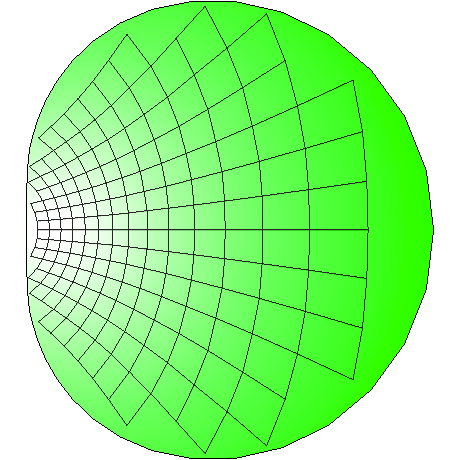GFtbox: Difference between revisions
No edit summary |
No edit summary |
||
| Line 1: | Line 1: | ||
=Why write ''GFtbox''?= | =Why write ''GFtbox''?= | ||
[[Image:GPT-logo-460.png|thumb|left|100px]] | [[Image:GPT-logo-460.png|thumb|left|100px]] | ||
'''To understand''' how patterns of gene activity in biological organs influence the developing shape. A key notion is that genes may regulate growth direction independently of growth rate. We formalised our ideas in the Growing Polarised Tissue Framework (GPT-framework, ref). | |||
Intuition is not, however, a good guide to how patterns of growth interact with each other and a continuous sheet of material to produce complex shapes. It is therefore necessary to translate intuition into a mathematical form (as a computable model) and compute the results. Rather than writing specific, custom software for each model we chose to produce a general purpose package: ''GFtbox'' within which individual computable models can be created. | '''Intuition is not''', however, a good guide to how patterns of growth interact with each other and a continuous sheet of material to produce complex shapes. It is therefore necessary to translate intuition into a mathematical form (as a computable model) and compute the results. Rather than writing specific, custom software for each model we chose to produce a general purpose package: ''GFtbox'' within which individual computable models can be created. | ||
This allowed us to test the veracity of the computational kernal using simple examples (Supplemental Text 1 in ref) before building a library of examples illustrating the properties of the GPT-framework (Results in ref) and embarking on modelling biological tissues (ref Green). Using ''GFtbox'' one can start with a simple sheet of tissue (the canvas), lay out experimentally observed, or hypothesised, patterns of regulator activity and then grow the canvas in 3D. Patterning can continue during growth and the final shape can be compared quantitatively with it's biological counterpart - so testing the hypotheses (ref Cui). | '''This allowed''' us to test the veracity of the computational kernal using simple examples (Supplemental Text 1 in ref) before building a library of examples illustrating the properties of the GPT-framework (Results in ref) and embarking on modelling biological tissues (ref Green). Using ''GFtbox'' one can start with a simple sheet of tissue (the canvas), lay out experimentally observed, or hypothesised, patterns of regulator activity and then grow the canvas in 3D. Patterning can continue during growth and the final shape can be compared quantitatively with it's biological counterpart - so testing the hypotheses (ref Cui). | ||
==What does ''GFtbox'' require== | ==What does ''GFtbox'' require== | ||
Revision as of 14:40, 4 May 2011
Why write GFtbox?
To understand how patterns of gene activity in biological organs influence the developing shape. A key notion is that genes may regulate growth direction independently of growth rate. We formalised our ideas in the Growing Polarised Tissue Framework (GPT-framework, ref).
Intuition is not, however, a good guide to how patterns of growth interact with each other and a continuous sheet of material to produce complex shapes. It is therefore necessary to translate intuition into a mathematical form (as a computable model) and compute the results. Rather than writing specific, custom software for each model we chose to produce a general purpose package: GFtbox within which individual computable models can be created.
This allowed us to test the veracity of the computational kernal using simple examples (Supplemental Text 1 in ref) before building a library of examples illustrating the properties of the GPT-framework (Results in ref) and embarking on modelling biological tissues (ref Green). Using GFtbox one can start with a simple sheet of tissue (the canvas), lay out experimentally observed, or hypothesised, patterns of regulator activity and then grow the canvas in 3D. Patterning can continue during growth and the final shape can be compared quantitatively with it's biological counterpart - so testing the hypotheses (ref Cui).
What does GFtbox require
How to start using GFtbox
Limitations of GFtbox
The following is parked here - just to remind me how it is done
[GFtbox]
<sgallery width="200" height="200" showarrows="true" showcarousel="true" showinfopane="true" timed="true" delay="6000"> Cycdich.jpg|This is the description for picture1 Arabidopsis_Leaf_ATH8bbg.png|This is the description for picture1 Grandison-Simulation.png|This is the description for picture1 PaulProjectPic.png|This is the description for picture1 Pierre_project_image.jpg|This is the description for picture1 </sgallery>
